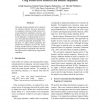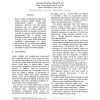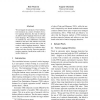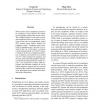ACL
2012
12 years 1 months ago
2012
Stanford dependencies are widely used in natural language processing as a semanticallyoriented representation, commonly generated either by (i) converting the output of a constitu...
ACL
2012
12 years 1 months ago
2012
This paper presents grammar error correction for Japanese particles that uses discriminative sequence conversion, which corrects erroneous particles by substitution, insertion, an...
ACL
2012
12 years 1 months ago
2012
Due to Arabic’s morphological complexity, Arabic retrieval benefits greatly from morphological analysis – particularly stemming. However, the best known stemming does not hand...
ACL
2012
12 years 1 months ago
2012
We investigate the potential of Tree Substitution Grammars as a source of features for native language detection, the task of inferring an author’s native language from text in ...
ACL
2012
12 years 1 months ago
2012
We present CSNIPER (Corpus Sniper), a tool that implements (i) a web-based multiuser scenario for identifying and annotating non-canonical grammatical constructions in large corpo...
ACL
2012
12 years 1 months ago
2012
SMT has been used in paraphrase generation by translating a source sentence into another (pivot) language and then back into the source. The resulting sentences can be used as can...
ACL
2012
12 years 1 months ago
2012
Mining retrospective events from text streams has been an important research topic. Classic text representation model (i.e., vector space model) cannot model temporal aspects of d...
ACL
2012
12 years 1 months ago
2012
Many semantic parsing models use tree transformations to map between natural language and meaning representation. However, while tree transformations are central to several state-...
ACL
2012
12 years 1 months ago
2012
We present a new edition of the Google Books Ngram Corpus, which describes how often words and phrases were used over a period of five centuries, in eight languages; it reflects...
ACL
2012
12 years 1 months ago
2012




